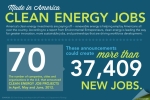Earlier this week Deputy Secretary Poneman also visited Environment Minnesota, where he spoke with members about their efforts to educate their community on the importance of clean energy tax credits. | Energy Department photo.
As part of a continued effort to keep and create clean energy jobs, this week Deputy Secretary of Energy Daniel Poneman traveled to Minnesota where he saw firsthand how clean energy tax credits are supporting businesses and putting communities to work.
Part of his visit included a tour of Daikin McQuay -- one of the world’s largest producers of heating, ventilation and air conditioning (HVAC) equipment and recipient of a $2.7 million Advanced Manufacturing Tax Credit, with $1.4 million spent in Minnesota. The tax credit was distributed as part of the Recovery Act, and has helped the company expand two of its Minnesota facilities: the manufacturing operations portion in Faribault and a technology center in Plymouth. Deputy Secretary Poneman toured the Plymouth facility with Mayor Kelli Slavik, who noted “the people of Daikin McQuay are looking to the future.”
And it’s true: Daikin McQuay is the first company to meet the standards of the Department’s Rooftop Unit Challenge, which challenged manufacturers to produce commercial air conditioning units that use 50 to 60 percent less energy than traditional rooftop cooling units.
Innovation like this is spurred by clean energy tax credits, including the Advanced Manufacturing Tax Credit and Production Tax Credit (PTC), that are set to expire at the end of this year if Congress doesn’t act to extend them. The Advanced Energy Manufacturing Tax Credit works in tandem with the PTC and provides a 30 percent investment credit to manufacturers who invest in capital equipment to make components, such as wind turbines, fuel cells, and advanced vehicle batteries, for clean energy projects in the U.S. These tax credits could create up to 100,000 jobs and create significant investment for companies just starting to bounce back as the economy continues to recover.
Following the tour in Plymouth, the Deputy Secretary met with members of International Brotherhood of Electrical Workers (IBEW) Local 343 in Rochester. Local 343 offers a wind certification program for union members interested in construction, installation, and maintenance jobs in the growing wind energy industry. The training facility features a 60-foot turbine tower section used to help train workers on deploying and maintaining wind turbine technology.
While the wind industry continues developing in Minnesota, energy generation from wind turbines has grown nationally by 27 percent over the last year. Production facilities are now in more than 40 states, employing thousands of workers, and boosting local economies. The PTC has directly helped drive this growth and is an important tax credit for utility-scale wind producers. If the PTC expires at the end of this year, the wind industry projects that nearly 30,000 jobs in the wind industry could be lost next year.
As evidenced by Deputy Secretary Poneman’s trip to Minnesota, these clean energy tax credits are helping create jobs and boost American manufacturing competitiveness and innovation. By halting support of these industries, we risk stunting the growth of our nation’s economy. Instead, the U.S. has the opportunity to win the global race for clean energy technologies…why turn back now?




